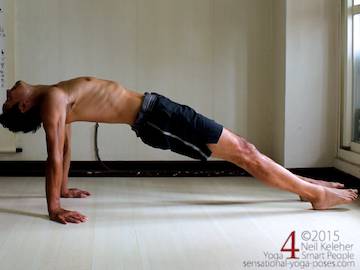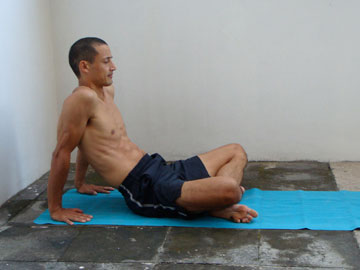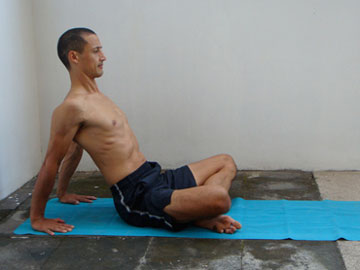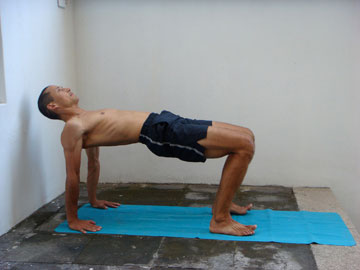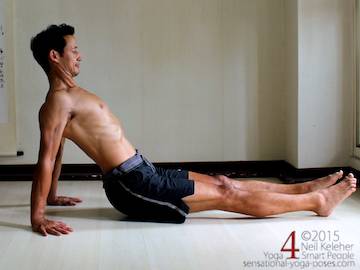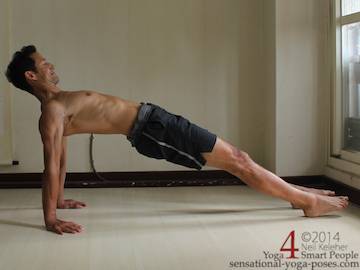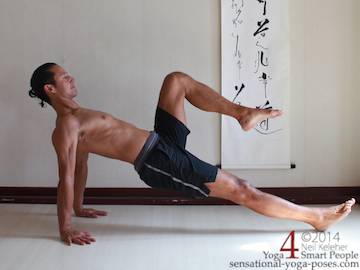Making Reverse Plank Less Dislikable
I know a lot of people who strongly dislike this pose. It's difficult.
The simple key to make this pose easier (even pleasant) is to push your hands forwards.
This same action helps to pull the chest up and back.
It also stretches the fronts of the arms and strengthens them at the same time.
Should the Fronts of the Feet to Touch the Floor in Reverse Plank?
I would suggest not worrying too much about getting the fronts of your feet to touch the floor while doing this pose.
Instead, focus on pushing your heels down into the floor.
If you do want to get the fronts of your feet to touch the floor then first focus on pushing your pelvis higher.
And that's the reason for pushing down with your heels.
The more you press your heels down, the higher your pelvis will go.
Beginners Tips
To practice the arm action of purvottanasana, sit with your legs crossed and your hands on the floor behind you.
Start with your fingers pointing forwards. (You could also try this with fingers pointing back!)
Use your shoulders to lift your chest by moving the shoulders back (relative to the chest) and your shoulder blades together.
(For more on improving shoulder blade awareness, try some of the exercises on the scapular awareness page.)
Then pull your hands forwards against the floor, as if trying to push the floor forwards. As a result your upper arms and chest will move back.
Now with your knees bent and feet on the floor, open your shoulders, push your hands forwards, and then use your feet to press your hips up. This is actually table top yoga pose.
From Table Top to Reverse Plank
Next try it with your legs straight.
In the first picture above my hips are on the floor.
In the second picture above my hips are only slightly lifted
Instead of lifting your pelvis all the way up on the first go try gradual increments.
Lift your hips a little, then lower (and relax). Then lift your hips a little bit higher.
Then lower and relax.
And repeat, each time lifting your hips slightly higher.
For the final repetition (try five) hold the pose and each time you inhale see if you can push your hips upwards slightly higher.
Or, each time you inhale try moving your ribs away from your pelvis (to create length and space) and try pulling your ears away from your shoulders (to lengthen your neck).
Then as you exhale try pushing higher.
For all movements, work at moving slowly and smoothly.
While holding reverse plank pose, keep your hands pressing forwards. Knees point upwards.
If possible, make your legs feel long. Make your body feel long also.
Increase the downward pressure on your heels to lift your pelvis higher.
If you like you can relax a little as you exhale, then as you inhale, push your hands forwards, lengthen your body and push upwards at the same time.
Why is Purvottanasana so Difficult?
One of the reasons that Reverse plank is so difficult, I believe, is because the center of gravity is far from the feet, which are helping to support the pose.
In table top yoga pose the feet are closer to the center of gravity so less work is required by the legs to keep the body supported.
The shins being vertical and the knees bent may also offer some mechanical advantages.
With the knees straight and the feet further away from the center of mass, as in reverse plank, the muscles of the backs of the legs have to work harder to lift the hips. In particular the hamstrings.
One of the reasons that I emphasize pushing the heels down is that it can help you to tune into the backs of your legs.
If you start of by pressing your heels down, but not with enough force to actually lift the hips, where do you feel the tension?
For myself I feel it in the buttocks.
But then as I lift higher, I start to feel my hamstrings (and the tendons at the back of the knee) "tightening".
And so one way of lifting higher in this pose is to consciously increase the tension in the buttocks and/or hamstrings.
If you can't feel the tension then try pressing the heels down without lifting the hips, then relax. Then repeat.
The on and off nature of this exercise should help you to notice the onset of tension when you press your heels down.
You can then choose to increase this tension to lift the hips higher.
As well you can try pressing your heels into the floor with greater pressure to lift higher.
Bending the Spine Backwards in Purvottanasana
One of the ways to possibly push deeper into reverse plank (i.e. get the pelvis higher) is to arch the back.
I prefer to arch the lumbar spine and thoracic spine backwards prior to lifting and keep them bent backwards while I lift higher.
What happens when you bend your spine backwards?
Ideally the spinal erectors activate to bend the spine backwards and if you practice this as an isolation exercise you can learn to feel when your spinal erectors are active.
And so to keep the spine bent backwards, maintain the contraction of the spinal erectors. Or you can choose to deepen the contraction and thus, possibly, the backbend.
As for the neck, I prefer to bend it forwards (and that's the way I've done the pose for the last few years) but it seems that traditionally in purvottanasana the head is allowed to move back and down so that the neck is bent backwards also.
If you've kept your shoulders retracted while lifting up and your thoracic spine bent backwards, you create a "base" for the neck. Since the thoracic spine is bend backwards you can then create a smoother curve in the neck when you let the head move back and down.
If this position is too uncomfortable then pull your head forwards and up and look towards your feet.
Lifting a Leg in Reverse Plank
An option in purvottanasana is to lift one leg. Prior to lifting a leg, press down with the other leg. If you are about to lift your left leg, press down with the right foot so that the left foot starts to feel more relaxed.
You may have to shift your pelvis slightly towards the pressing down leg side.
Then lift the non-pressing down leg (in this case, the left leg.)
You can try lifting the foot an inch off of the floor first (not shown.)
From there try bending the knee and lifting the leg higher, then try straightening the knee if you feel like your low back can handle it okay.
To keep the pelvis lifted you have to press down strongly with the leg that is down.
In addition you may have to stabilize the hip or the waist, or both, to keep the pelvis level from left to right.
This position will be a little bit easier if you lean the lifted leg a little inwards (viewed from front or behind). It will possibly be more work it you try to make the leg vertical (viewed from in front or behind.)
Published: 2011 07 16
Updated: 2020 10 28
